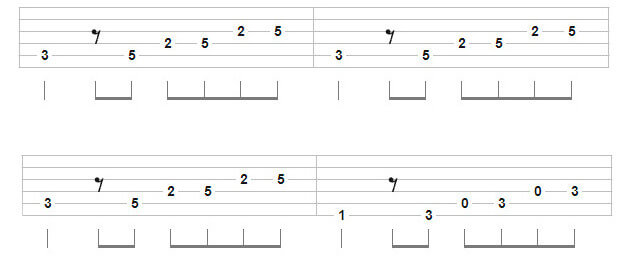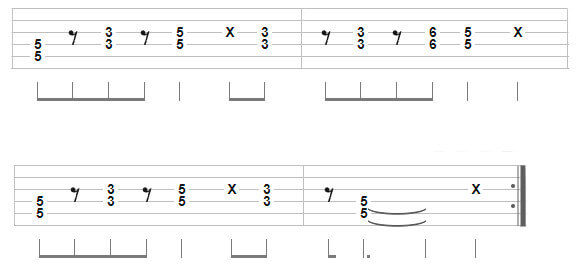Table of Contents
Guitar riffs and licks are foundational elements of modern music. They are a crucial part of any guitar player’s vocabulary.
From death metal to modern pop! They have been used to create some of the most memorable tunes in history. But what is a guitar riff? What about a lick?
A guitar riff is a collection of notes or chords that form the structure of a verse or chorus. A lick on the other hand is more of a complimentary phrase. It’s played overtop of a riff to accentuate the theme of the music. You might also have heard it referred to as a lead line.
This Killer Rig article will explore the fundamentals of guitar riffs and licks. Additionally, their significance and how they might be utilized to produce outstanding music.
We’ll go over some pointers and strategies for creating and mastering guitar licks and riffs. As well as highlighting some of each type’s more effective and difficult examples.
What is a Guitar Riff?
A riff is a short musical phrase or sequence of notes played on the guitar. It’s typically repeated multiple times throughout a song.
Riffs are usually built using chord progressions and often serve as the hook or main melody.
They are usually played on the guitar’s lower strings. But often consist of simple, memorable, and catchy notes. Riffs can be played in various styles and genres of music. This includes rock, blues, metal, and pop, among others.
Think of the song Smells Like Teen Spirit by Nirvana. The first 4 chords you hear as the song starts are the main riff. It’s then repeated for the majority of the tune. Riffs are an essential component of most songs. They can greatly enhance the musicality and impact.
What Makes a Good Riff?
A good guitar riff is characterized by its simplicity, memorability, and catchiness. It should be easy to play and memorable so that the listener can easily recognize it and hum along. The melody of the riff is essential to make it stick in the mind of your audience.
While a rhythm is necessary to give it drive and energy. Repetition is important because it allows the riff to become ingrained in the listener’s mind.
Like our example of Smells Like Teen Spirit. Those 4 chords are played for the majority of the song. But they are very catchy and make an impact. Most people know exactly which song is being played when they hear that riff.
What are the Hardest Guitar Riffs to Play?
There are some very difficult riffs in all forms of music. Riffs that are very fast, or just have some complex arrangements. This difficulty obviously relies on many factors. Your experience and skill level are going to be what determines if a riff is hard to play.
This isn’t the same for everyone. Yet there are some songs that most players know to be hard! Here are some examples from a few different genres of music:
- Bleed by Meshuggah.
- Preludio e Toccatina by Assad.
- Little Bit of Sympathy by Robin Trower.
- Breaking all Illusions by Dream Theater.
- Albeniz’s Asturias.
Learn Master of Puppets Chords here!
What are the Best Riffs to Learn?
The best riffs to learn are those that are both challenging and rewarding. But they must also be riffs in songs that you like! No player learns guitar riffs unless they like the style of music. Otherwise, you may get bored and lose interest in the guitar!
But learning a variety of riffs from different genres can help you expand your musical vocabulary. Overall, it will improve your playing skills. So keep this in mind as you progress.
Some riffs that are popular can be found in songs like Smoke on the Water by Deep Purple. But also Sweet Child O’ Mine by Guns N’ Roses, and Satisfaction by The Rolling Stones.
However, the best riffs to learn are ultimately subjective. It depends on the individual player’s skill level, musical preferences, and goals. It’s recommended that guitar players start with simple riffs. Then gradually work their way up to more complex ones.
Here are a some easy riffs a beginner can start with right away:
My Girl by The Temptations
This is a very famous song with a great riff. The main chord is the C Major and is an easy riff to play. Beginners often start with this song because it’s quite simple. Plus, it sounds good. Here are the tabs that will help you to see how this riff has been created.

Smoke On The Water by Deep Purple
Another very popular riff is Smoke On The Water by Deep Purple. This is one riff that beginners tend to learn, as it’s fun and easy. It consists of some easy barre style chords and has a great sound. Especially on the electric guitar. Here is the chord tabs:

Learn the 11 chords that are best for beginners here!
How to Write Guitar Riffs
Writing guitar riffs is a creative process! It requires a combination of technical skills, musical knowledge, and imagination. To write a good riff, it’s important to understand the basics of music theory. This relies heavily on chord progressions, scales, and modes.
Ideas for riffs can be created by experimenting with different chords, tones, and rhythms. It’s also helpful to listen to a variety of music to get inspiration for new riffs.
Understanding how various genres and styles are put together might encourage them. Just make sure your riffs are original.
Once you have an idea for a riff, practice playing it repeatedly to refine it. Eventually, you will find a groove that is all your own.
Don’t be afraid to experiment with notes in multiple scales. Try new things to get a feel for tones. Some of the best riffs are created by accident and through experimentation. I have written tons of riffs this way!
What is a Guitar Lick?
A guitar lick is a short, recognizable sequence of notes. A lick is used to add interest and variety to a riff or to create a specific musical phrase. Licks can be based on scales, arpeggios, or chord progressions.
They range in complexity from simple single-note patterns to complex phrases. You can utilize licks to set an ambiance or mood.
Creating a bluesy atmosphere or a quick and intense rock solo, for example. Licks are a crucial component of a guitarist’s vocabulary.
They can be created to give their playing more depth and expression. They normally don’t repeat either and so aren’t like riffs. This video demonstrates a lick on many different instruments.
Why is it called a Guitar Lick?
It’s unclear where the term lick originated. But it has been used for many decades! Some people believe it was created in the Jazz scene in the 1930s. Because a lick is a short phrase that compliments the structure of a song, it makes sense.
Sort of like a small taste of a musical expression. The term lick is the perfect way to describe it. And most players know exactly what you mean when you say it!
Are Licks Important?
Licks play a crucial role in a guitarists’ expression! They bring a special touch to their playing.
By including licks, players can create different moods and add flavor to their solos. Licks are like spices that bring a new dimension to a song. They make it more exciting and dynamic.
Without licks, some of your favorite songs wouldn’t be as moving. The passion would be lost if they were not included. When building up to a climatic part of a song, the licks normally provide anticipation or thrill.
When to Use Licks
A well-placed lick can significantly impact the mood and direction of a song. It might make a difference in whether it comes to life.
For instance, a bluesy lick can evoke feelings of sadness and soulfulness. Whereas, an energetic rock lick can convey a fast-paced and high-energy vibe.
Licks can also bring diversity to a guitar part by introducing new musical ideas. They can break up repetition in a hurry. This can add interest and keep listeners engaged.
When incorporating them into your playing, it’s important to choose licks that complement the music. This means considering factors such as tempo, key, and overall style of the song.
It’s crucial to utilize licks musically and tastefully. This means considering the phrasing, dynamics, and overall flow of the song’s theme.
A lick might even need to follow along with the vocals. Licks should enhance the music and add to its overall impact, not detract from it.
What are the Most Complex Licks?
Some players are just incredible, that is something we can all agree on. I have seen some very difficult licks that just sound amazing. Licks that I’m not sure if I will ever be able to play in the same way they do! Here are some of the most complex licks out there:
- Fives by Guthrie Govan.
- Cliffs of Dover by Eric Johnson.
- The Attitude Song by Steve Vai.
- Blackstar by Yngwie Malmsteen.
Difference Between Guitars Riffs and Licks
Riffs and licks are two commonly used terms in the world of guitar playing. Yet, they are not interchangeable.
A riff refers to a repeating musical phrase that serves as the main hook or backbone of a song.
Riffs are usually played at the beginning of a song and set the tone for the entire piece. On the other hand, a lick is a short, standalone phrase.
It’s perfect when used to fill in the gaps between chords or verses. Licks are typically used to add flavor and interest to a song.
They are usually not repeated as frequently as riffs. Both riffs and licks can be used to create a memorable guitar melody. But they serve different purposes in a song, as we have seen. Their unique characteristics set them apart.
| Guitar Riff | Guitar Lick |
|---|---|
| Riffs make up the theme | Licks are short musical phrases without a theme |
| The song hook is formed by the riff | Excitement and intensity are added by licks |
| They are normally made from chords | They are generally a collection of notes |
| They form songs through syncopation | They are added sporadically |
FAQ
Is a Guitar Solo a Lick?
Licks and solos on the guitar are two different things. A lick is a brief, identifiable phrase. It’s used to spice up a song with appeal and expressiveness.
A solo is a longer performance that showcases the guitarist’s skills and creativity. A guitar solo can consist of a combination of licks, riffs, and other materials.
What is the difference between a guitar riff and chord?
Guitar riffs are constructed using chords and notes. Chords are the building blocks, while riffs are your final product.
Chords themselves are built using notes as well, but when you play them, you get one sound. Riffs are a number of them assembled together to make musical phrases.
How many notes are in a lick?
A lick can contain as many notes are you desire. This depends on the structure of the song or riff it’s being played over.
However, some styles of music have limited licks to a certain number of notes. In some Jazz music, you will find that players aim for 5 notes per lick. In others, it’s 7 notes.
You can play them as long as you like, but the goal is to stick to only these notes. In most cases, you will find that you don’t need more than this. But you also don’t want to limit yourself.

